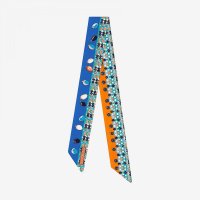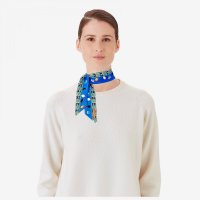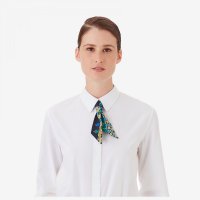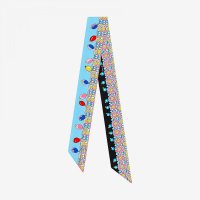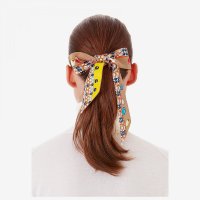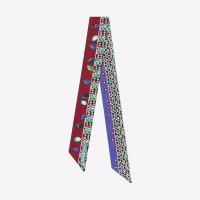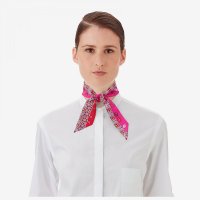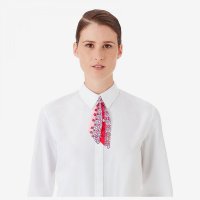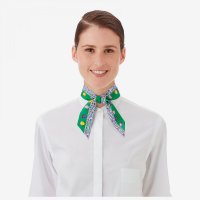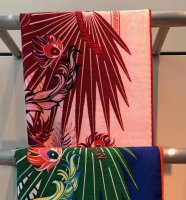Short stories for some of the designs.
1. Une Rose Pour Alma (A rose for Alma) - Manuel Canovas de Lorca
Manuel Canovas is the founder of the house that has borne his name since 1963. He is best known for his designs for fabrics and wall papers. In recent years, his love of roses has inspired a series of drawings presented as gifts to his nearest and dearest. This inaugural design for Hermes is dedicated to his daughter, Alma.
2. H en Fil by Bali Barret
The Hermes H emerges from the interplay of shafts of coloured lines, taking us back to the Seventies. Art ushered in new decorative forms, including the seductive line pictures. A technical feat of print-making, to reproduce the complex, virtuosic design on silk.
3. Planisphere D'Un Monde Equestre by Jerome Colliard
In this imaginary world, place names are inspired by all things equestrian: equipment, places and figures give rise to imaginative names for the continents, bays and other features. This designer's first carre for Hermes is inspired by a giant mappermonde (world map or planisphere) which he created for the 2016 Saut Hermes in Paris.
4. Coupe de Gala by Wlodek Kaminski
Commissioned in 1894 by the Chinese Empress Tseu-Hi, this carriage is pulled by four horses led by footmen. The
coach was upholstered in padded silk, and decorated with giltwood and morocco leather. The house of Hermes created the red harness-work, with its finely-engraved metal parts. Indian gems and jewels frame the composition, the styles mingle to strangely seductive effect: when the theme of the year is "Play", anything goes!
5. Jeu de Soie (A silken board game) by Gianpaolo Pagni
A traditional, 19th-century French board game in the Emile Hermes collection (know as Jeu de l'oie) was Gianpaolo Pagni's inspiration for this Jeu de Soie. All that remains from the original game are the linear trail or track, and the numbers. The contents of each square have been replaced by block printed motifs. The technique is central to the concept underpinning Pagni's work: the notion of the "imprint" of memory. Here he composes a world of chain-links, waves, circles, lines, triangles, and squares - a language of motifs evoking the process of printing on silk.
6. Le Tour du Monde en 63 Cases (Around the world in 63 squares) by Pierre-Marie
Pierre Marie's composition is a traditional "trail" board game taking us to the four corners of the Earth. Our itinerary is determined by a throw of the dice - from Iceland to Hong Kong, the Loch Ness monster or the giant turtles of the Seychelles, and from Emile Hermes in Saint Petersburg (square 18) to Leila Menchari in her garden (Square 36). The designer's entertaining and imaginative world tour leads us at least to no. 24, Faubourg Saint-Honore.
7. Baobab Cat by Ardmore Artists
For the Zulu people of Southern Africa, the leopard and the baobab tree symbolise strength, nobility and power. Baobab flowers open at nightfall, when the leopard roams the savannah in search of his prey. The composition blends the animal and the vegetable, into a single being.
8. Cache-cache Fleuri (Floral hide-and-seek) by Pierre-Marie
This playful, floral composition combined imaginary and real species, including lilies, carnations, peonies, irises and tulips. Designer Pierre-Marie has hidden 24 charming, poetic characters: see if you can spot them.
9. La Serpentine de Pierre Charpin by Pierre Charpin
The carre presents a colourful encounter between two worlds: the house of Hermes, and French designer Pierre Charpin. The abstract form, with its bold, flat expanses of colour is wholly characteristic of his work. "The board ribbon clearly describes a space - an abstract space, but one which we can imagine someone entering", says Charpin. Naturally, in this carre, that "someone" is none other than a horse.
10. Lettres au Carre by Archives Hermes
From the Hermes archives, this Art Deco alphabet was created in the 1930s for a specially-commissioned piece. It is notable for the absence of the letter W, removed to conform to the carre's symmetry, creating an ultra-modern geometric ensemble.
11. Panoplie Equestre (Equestrian panoply) by Virginie Jamin
Virginie Jamin takes inspiration from the illustrations in a 19th-century catalogue of equestrian articles (a travelling salesman's album, non-Hermes items), to create an original, graphic composition of bits, leather and steel.
12. Selle de Dignitaire (A dignitary's saddle) by Wlodek Kaminski
Wlodek Kaminski's model is a saddle in the Emile Hermes collection. Made in central Asia and dating from the first half of the 19th-century. It is thought to have belonged to a Chinese dignitary. The piece is crafted with exceptional skill, from wood, leather, coral, amber and lapis lazuli: rich materials that are metamorphosed in each of the care's colourways.
13. Acte III, Scene I, La Clairiere (Act III, scene 1, The Clearing) by Edouard Baribeaud
The carre and its name are inspired by a scene from William Shakespeare's late 16th-century play A Midsummer Night's Dream. Titania, the Queen of Fairies, falls madly in love with Bottom, a village actor magically transformed so that he has the head of a donkey. This debut design for Hermes by young Franco-German illustrator Edouard Baribeaud conveys a strange, poetic atmosphere.
14. A Travers Champs (Across the fields) by Marie Bonnin
The young illustrator takes inspiration from her childhood home and village in the Auvergne (in central France), presenting the landscape as a children's board game, or a maze. The design's concentric circles feature the Auvergne's characteristic houses, tress, fields and extinct volcanoes.




 Also—thank you so much
Also—thank you so much 
